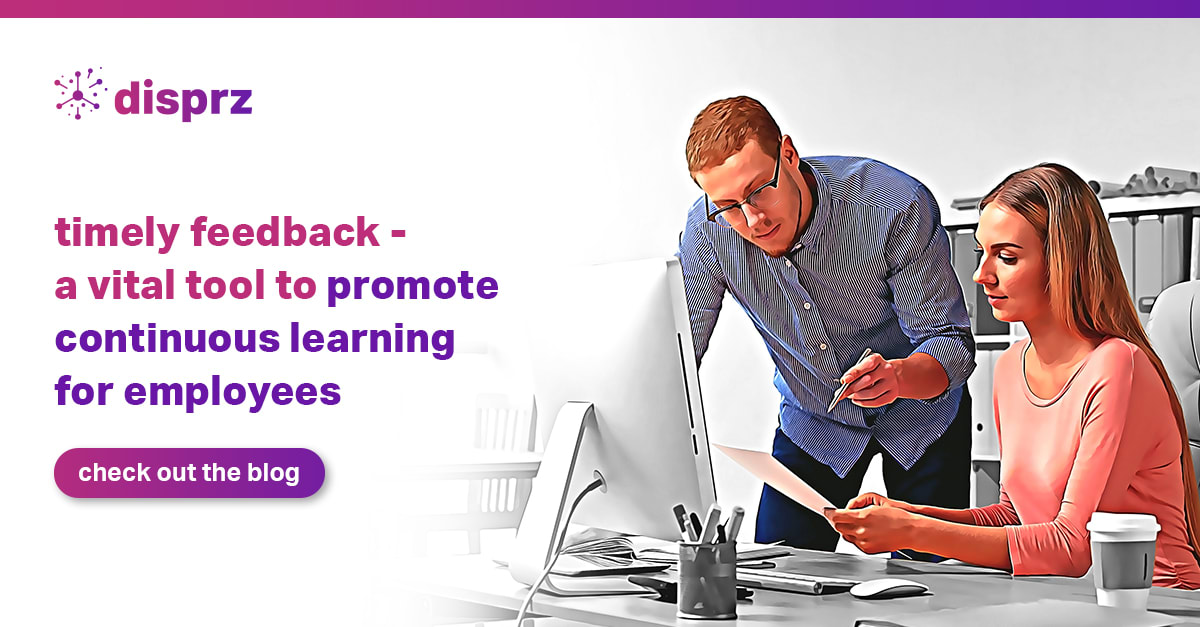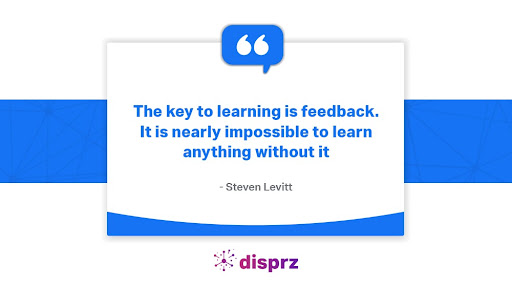Timely Feedback: a vital tool to promote continuous learning for employees

It’s no secret that timely feedback is an incredibly powerful tool to boost employee learning and development. Making feedback a part of the learning journey can help identify and address hurdles in real-time. In fact, even employees are interested in feedback to improve performance and expand their skillset. Constructive feedback helps establish a positive work environment where employees can continuously improve and grow. Feedback has the potential to engage employees and drive learning behavioural change.
43% of highly engaged employees receive feedback at least once a week. Feedback need not be a one-way street; having a feedback system between employees and L&D professionals/managers can benefit workplace learning.

Why is meaningful feedback essential during learning and development?
Timely and meaningful learning feedback is one of the best ways to address both success and failure. When employees and L&D professionals/managers have clarity on what’s going right or wrong, they can act in real-time to be more successful.
Below are the perks of meaningful feedback:
- A quick analysis of problems
- Better understanding and assimilation of content
- Encourages self-reflection
- Real-time identification of improvement areas
- Ensures learners and L&D team/managers are on track
4 tips to provide timely feedback for cultivating a continuous learning culture :
You’ll agree that employee L&D programs consume a lot of time, effort and money, which you surely wouldn’t want to waste on ineffective and irrelevant learning programs. What’s great about timely feedback is that it provides opportunities to improve learning and development programs continuously. That said, here are a few effective to provide timely and meaningful feedback:
Harnessing technology to provide insight-driven feedback:
Feedback should be based on insights rather than assumptions. So dig deep into learning analytics to provide insight-driven feedback to your employees. An analytics builder can help convert raw learning data into actionable insights to understand a learners’ behaviour and give constructive feedback.
Moreover, with a KPI score in a complete skilling suite like Disprz, you can set a target value and track the KPI score. You can monitor if the employees exceed or fail to reach their targets with a detailed view of the KPI score on the learner’s dashboard. Accordingly, you can provide feedback and level up the learning programs to improve performance.
Regular check-ins to track and discuss learning progress :
You’ve analysed the employee’s skill gap, created a complete learning program and assigned it to the employees. But are the employees completing the learning journey or abandoning it mid-way? Regular check-ins are essential for finding the answer to this question.
It is pivotal; to check the learner’s progress and provide feedback at the right intervals to ensure the learner are completing the journey. With an LMS+, you can easily get a complete view of the learner’s journey to conduct regular sessions for quick evaluation.
Two-way feedback to make learning programs more effective :
Giving and receiving feedback is a skill that everybody must master to enhance learning journeys. Manger/L&D professionals should not only give but also take feedback from the employees to address the roadblocks in the learning process. It is important to understand whether the training programs are relevant and add value to each employee.
You can conduct one-to-one meetings or surveys to take the feedback of the employees. Nowadays, most learning solutions have advanced features like Gameinar, where you can conduct interactive learning sessions and take feedback on the spot through polls, text walls and sticky notes.
Positive reinforcement to appreciate hard work and improvement :
Positive reinforcement drives employee motivation and encourages them to put in more effort. Employees are working hard to learn new skills and improve their performance, so appreciate employees’ effort through positive feedback.
As per research, a robust reward program that addresses motivation to learn is capable of increasing employee performance by almost 44%.
Intrinsic motivation works well for some employees. They themselves are motivated to enrol in different learning courses for career advancement. While some employees need a nudge through extrinsic motivation like positive feedback in front of colleagues. So make sure you keep providing positive reinforcements to encourage employees to extend their skill set to keep the arc of success curving up.
Conclusion:
Feedback driven learning culture can help boost the overall success of the learning and development programs. Feedback blended with action and amendments can create a continuous learning environment. So, improve your employee learning experience with constructive feedback. Make sure your feedback is relevant and focused on specific details to avoid confusion. Along with giving feedback, even be open to taking feedback from the employees for maintaining a healthy learning ecosystem in your organisation.


